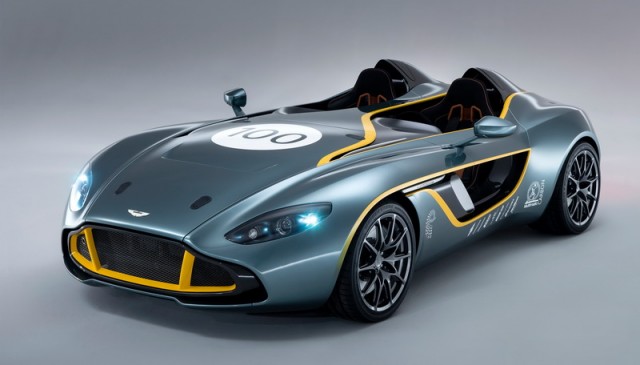Aston Martin is looking both forwards and backward with the unveiling of the CC100 Speedster Concept. It's meant as a celebration of both the famed sports car firm's 100th birthday and it's historic, sole, victory at the Le Mans 24hrs.
It was in 1913 that Lionel Martin decided to make sporting cars bearing his own name, and he combined it with the name of the Aston Clinton hill-climb where he had scored many successes. Aston Martin was thus born and through times both good and bad, turbulent and successful, through David Brown, Victor Gauntlett, Walter Hayes and, of course, James Bond, Aston Martin has endured.
The CC100, which uses Aston's existing VH (Vertical, Horizontal) chassis system (made from extruded, bonded and riveted aluminium as well as increasing amounts of carbon fibre), shares much with its road-going production cousins such as the DB9 and the new Vanquish. It uses the same 6.0-litre V12 petrol engine and a new automated-manual gearbox, controlled by racing-style gearshift paddles mounted behind the steering wheel. It's thought that Aston will build just two CC100s, to be sold to collectors at a price of around €830,000 to €950,000.
The body styling, by Aston's in-house designer Marek Reichmann, is all swoops, bulges and aggressive intent. With its totally open cockpit it's meant to evoke memories of the great Aston Martin sports cars of the 1950s, including the DBR1 with which Aston scored its one and only victory in the Le Mans 24hrs, in 1959.
The drivers that day were Carroll Shelby and Roy Salvadori, but when the CC100 made its debut, in front of tens of thousands of fans attending the Nürburgring 24hrs race, it was accompanied by both an original DBR1 and another legendary Aston Martin racing alumnus - Stirling Moss, who won both the Nürburgring 1,000km and Goodwood Tourist Trophy races in 1959 with Aston.
The CC100 would of course leave a DBR1 for dead, in spite of the older car's racing heritage. Aston claims a 0-100km/h time of little over four seconds, while the top speed is 'limited' to just under 300km/h.
While Moss, the racing legend, drove the original DBR1 in formation with the CC100, the new car was driven by Aston Martin boss Ulrich Bez. Bez is carving out quite the legendary niche in Aston circles for himself and the ex-Porsche man has been largely responsible for the creation and expansion of Aston Martin's current range.
"The CC100 is the epitome of everything that is great about Aston Martin" he said. "It represents our fantastic sporting heritage, our exceptional design capability, our superb engineering know-how and, above all, our adventurous spirit."
It also won't have escaped people's notice that Aston is being very strategic about the unveiling of the CC100 in Germany. Quite apart from the brand's successes, both historic and contemporary, in racing at the Nürburgring, Aston is currently deep in negotiating a strategic alliance with Mercedes-Benz.
While Merc is certainly keen to get its hands on Aston's heritage and its expertise in lightweight, low-volume production, Aston's desire for a relationship with the German giant is even more pressing. The British sports car maker is currently independent of other car manufacturers, owned jointly by a Kuwaiti investment fund and finance house Invesdustrial. While sales are currently buoyant, Aston needs a major car maker as a partner to help it leapfrog upcoming legislative hurdles, as well as to help defray the swingeing costs of developing next-generation engines and chassis.
The 6.0-litre V12 powering the CC100 is still Aston's core engine, and it sounds just as spectacularly good as it goes, but it's ageing fast - it's based on Ford technology whose roots stretch back as far as the early nineties.
Aston will also be using the Nürburgring 24hrs to give the new hydrogen-hybrid Rapide race car its public debut. The 500hp racer has a modified V12 engine that can run on either petrol or liquid hydrogen and is expected to run on the latter for about one fifth of the race distance. It's seen by Bez as key technology to driving down Aston's emissions footprint, and if it can be made work, all Astons could be hydrogen powered in the future. Again, Mercedes' expertise with hydrogen fuel cell power could be crucial in aiding Aston to develop this technology.
So while the laps driven by the CC100, the DBR1, by Moss and Bez today are a great celebration of a great car maker, make no mistake - the fact that the laps were driven in Germany speaks volumes about Aston's next 100 years.

